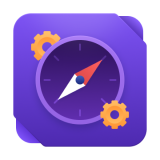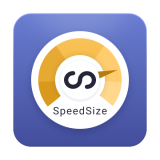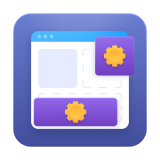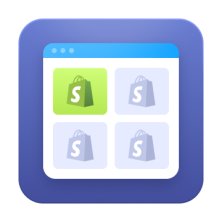According to Statista, 77% of all e-commerce traffic has come from mobile devices in Q1 2025. More to that, 73% of those online shoppers prefer mobile apps to websites.
Mobile shopping corresponds with the hectic pace of our lives today, as it is available on the go. All it needs is a dedicated mobile app that will automatically notify you when your order is ready, a new collection is released, or a sale is coming.
As people actively use e-commerce mobile apps, so should retailers and store owners in order not to fall out in the competition. In this guide, we’ve prepared a step-by-step guide to highlight easy and available options for turning Shopify stores into mobile apps.
Why You Should Turn Your Shopify Store Into a Mobile App
Let’s take a more detailed look at why you should create a Shopify mobile app for your e-commerce store.
Mobile traffic share growth. As we’ve mentioned before, mobile devices have generated 77% of e-commerce traffic in the first quarter of 2025, and this number is expected to grow further. Consequently, the desktop share of e-commerce traffic gradually declines.
Mobile revenue growth. Growing mobile traffic in e-commerce generates growing revenues. This way, ignoring mobile apps will cost a Shopify store owner a fortune, resulting in lost profits.
Conversion rate improvements on mobile apps. Smartphones have the highest ATC (add-to-cart) rate for e-commerce (14.1%). Thus, creating a Shopify mobile app for your store means converting your website into a mobile-native format with a dedicated design, intuitive navigation, and optimized layouts. This lets you improve conversion rates, offering your to-be-clients simpler customer journeys.
Push notifications & user retention. Push notifications in Shopify store apps allow improving user retention up to 2.8-5 times compared to e-commerce websites. Retention rate is actually a tricky and complicated thing with a tendency to steadily decline over time, yet push notifications that are common for mobile applications help improve it without being offensively annoying.
Competitive edge. In the era of on-the-go everything and with everyone having pocket-sized PCs every single minute, ignoring mobile applications in e-commerce can be a fatal mistake. Creating a mobile app for your Shopify store offers you a whole big market of in-app buyers and lets you stay competitive in the challenging e-commerce niche.
Options to Convert a Shopify Store into a Mobile App
After we have listed the reasons for creating a mobile app for your Shopify store (and convinced you to do this), let’s dig deeper into the options of how to do this.
There are three main ways of converting a Shopify store into a mobile application: using a no-code/low-code app builder, developing a custom app integrated with Shopify Storefront API, and using a Shopify Mobile Buy SDK.
No-code/low-code app builders
No-code or low-code platforms enable quick e-commerce mobile app development without deep technical expertise. These solutions are cost-effective, offering templates and pre-built components to convert your Shopify store into an app. However, their pre-defined nature comes with limitations, such as the absence of robust customization options and scalability challenges for more complex requirements and bigger stores.
Pros:
Quick and cost-effective
No profound coding expertise required
Pre-built templates tailored for Shopify stores
Cons:
Limited customization and flexibility
Less control over features and app behavior
May struggle with scaling or advanced features
Custom mobile app development using React Native or Flutter + Shopify Storefront API
Building a custom e-commerce mobile app with frameworks like React Native or Flutter provides sufficient scalability and flexibility. By integrating with Shopify’s Storefront API, you can sync real-time data such as products, cart, and user accounts directly to the mobile app. This approach requires development expertise and implies prolonged time-to-market, but offers full control over design, features, and performance.
Pros:
Full control over app features and design
Native-like performance on both iOS and Android
Scalability for future growth and feature additions
Cons:
Requires expertise in mobile development
Higher initial development and maintenance costs
Longer time to market
Shopify Mobile Buy SDK or headless architecture
For Shopify e-commerce businesses seeking a more advanced, scalable, and customizable solution, Shopify’s Mobile App SDK or headless architecture may be the appropriate choice. The SDK allows for deeper integration with Shopify’s platform, while headless setups enable complete flexibility in how the front-end interacts with the Shopify backend, ideal for large or rapidly growing stores.
Pros:
Advanced customization and scalability
Seamless integration with the Shopify ecosystem
Ideal for complex and large stores with specific needs
Cons:
Requires extensive technical expertise
High development and maintenance costs
More time-consuming to implement
In summary, these methods of creating a mobile app for a Shopify website are listed in descending order regarding price and implementation complexity. Which one to choose? It depends on your business considerations and needs. Say, small businesses and those on a budget can proceed with no-code/low-code options. If you plan to scale up your e-commerce store and want a more powerful, customized application, then consider custom Shopify app development or headless architecture + Shopify Mobile Buy SDK.
Step-by-Step: How to Create a Shopify Mobile App
Converting a Shopify store to a mobile app has an algorithm that we recommend you follow in order to keep the development process structured and avoid possible pitfalls.
Step 1. Choose your app type (builder vs. custom)
Decide whether you want to use a no-code app builder or create a fully custom app. Consider your store’s requirements, budget, and the level of customization you need. No-code solutions are quicker but limited in flexibility, while custom apps offer more features and control.
Step 2. Plan features: cart, login, wishlist, push, etc.
List the key features you want in your app, such as a shopping cart, user login, wishlist, push notifications, and any integrations with Shopify's checkout system. Prioritize features that enhance user experience and drive sales, ensuring they’re aligned with your business goals.
Step 3. Connect Shopify via API or Mobile Buy SDK
Use Shopify’s APIs or Mobile Buy SDK to integrate your Shopify store with the app. The Storefront API is ideal for custom mobile apps, while no-code solutions typically come with built-in integrations for easier connectivity.
Step 4. Design the app UI
Create a user-friendly and visually appealing app interface. Focus on simplifying navigation, optimizing for mobile devices, and ensuring your design reflects your brand. Tools like Figma or Adobe XD can help design the UI before moving to development.
Step 5. Test on iOS and Android devices
Test the app on both iOS and Android devices to ensure it performs as expected before the app goes live. Pay attention to speed, compatibility, and usability, fixing bugs or issues that arise during testing.
Step 6. Publish to app stores (Apple, Google)
Publish your Shopify mobile app to the Apple App Store and Google Play Store once it is tested and ready for launch. Follow the guidelines for each platform, ensuring all necessary documentation, screenshots, and app details are in place for approval. This step may take time due to app review processes.
Features to Include in Your Shopify Mobile App
In addition to basic features of an e-commerce mobile app, such as cart, login, wishlist, etc., consider adding some more sophisticated ones. Doing so will help you improve users’ interaction with your app and simplify usability, which, consequently, positively affects customer satisfaction and improves loyalty and retention.
Personalized homepage. Tailor your Shopify app to have a dynamic homepage based on user preferences, browsing history, or past purchases. This improves user engagement and increases the likelihood of conversions by showcasing relevant products as users open the app.
Real-time inventory sync. Ensure that the app reflects the most up-to-date inventory. Real-time syncing between your Shopify store and mobile app helps avoid issues like selling out-of-stock products, preventing cart abandonment, and decreasing bounce rates.
One-tap checkout. Simplify the purchasing process by offering a one-tap checkout. This allows users to quickly complete purchases without having to navigate through multiple screens and switch between your app and the payment provider, improving conversion rates and customer satisfaction.
Push notifications. Engage with your customers directly through push notifications. Whether it’s about sales, new arrivals, cart reminders, or order updates, push notifications keep your customers informed and encourage repeat visits to your Shopify app.
Loyalty/rewards integration. Reward your customers with a seamless loyalty and rewards program integrated into the app. Allow users to earn points and in-app currency, get discounts, and redeem rewards directly from the app, stimulating repeat purchases and improving customer retention.
To help you choose the Shopify app builder for your e-commerce store, we’ve made up a comparison table where you can compare the most popular market players and their key characteristics.
App builder | Type | Pricing, from (USD) | Speed/performance | Native vs. Hybrid | Notes |
Custom | Varies (Contact for quote) | High | Native | Custom solutions tailored to business needs, with over 15 years of experience | |
Plobal Apps | No-code | Starts at $199/month | Fast | Hybrid | Quick setup, good for small stores, strong push notifications |
Shopify App by Vajro | No-code | Starts at $149/month | Moderate | Hybrid | Strong UI customization, good support |
Tapcart | No-code | Starts at $250/month | Fast | Native | Excellent for conversions, branded experience |
Shopney | No-code | Starts at $149/month | Moderate | Hybrid | Affordable, easy to launch, quick |
Custom React Native or Flutter | Custom | Varies, depends on the provider | High | Native | Full control, scalable, tailored features |
Shopify Mobile Buy SDK or Headless | Custom | Varies, depends on the provider | High | Native | Ideal for large stores needing custom integrations |
Shopify Mobile App Development: Key Technical Considerations
Converting a Shopify store into a mobile app becomes easier if you are aware of the key technical aspects. May this checklist help you:
Storefront API basics for data synchronization
Shopify Storefront API is a powerful GraphQL-based API that allows you to interact with your store's data, such as products, collections, and customer information, directly within your mobile app. Storefront API enables synchronization between the app and your Shopify store, allowing for real-time updates of product catalogs, customer accounts, and orders.
Caching strategies for faster loading times
Caching strategies help you enhance performance and reduce server load in your app. Cache static data, such as product information, images, and collections, to ensure faster load times and a smoother user experience. Cache-first and network-first approaches can be used based on the type of data, ensuring that the app remains responsive even when network connectivity is intermittent.
Offline mode for uninterrupted user experience
Enabling offline mode is necessary for providing a seamless shopping experience, especially when your users are in areas with limited internet connectivity. Use local storage to collect critical data (e.g., products, cart items, user preferences) and ensure that customers can browse and add items to their cart even without a network connection. Once the connection is restored, sync the data back to the server.
Payment methods in apps for easy purchasing
Ensure your app integrates easily and securely with various payment gateways (e.g., Shopify Payments, PayPal, Stripe) for easy and quick transactions. The payment process should be smooth, allowing users to make purchases quickly (one-tap checkout is a preferable option), whether they're using a credit card, mobile wallet, or other payment methods. Follow platform-specific guidelines (Apple Pay, Google Pay) to ensure compliance and security.
Shopify App Performance Optimization Tips
Smooth and seamless e-commerce app performance depends not only on the technical correctness of all the elements, which actually goes without saying. Optimizing the visual side of your mobile app can greatly improve performance, too, increasing customer satisfaction and preventing bounce rate growth.
So, here’s what you should do to optimize the performance of a Shopify app:
Minimize the app size by optimizing assets like images and scripts.
Use lazy loading for large product images to reduce initial loading times.
Optimize API calls by reducing the number of requests and using batching where appropriate.
Implement compression for JSON responses to speed up data transfer.
Prioritize smooth navigation and responsive design for a seamless user experience across various screen sizes.
Is a Shopify Mobile App Worth It?
Mobile e-commerce applications are really popular today, and this popularity keeps growing. This way, turning a Shopify store into a mobile app definitely offers a lot of benefits, including revenue growth, increased brand visibility, improved conversion rates, and better customer loyalty and client retention.
Wisely choose an e-commerce app builder based on your business size and growth plans, list your app in app stores, and get ready to welcome new orders and customers. One more recommendation – offer your customers the app you would gladly use yourself.
In case you decided to proceed with a custom app, contact Amasty Shopify app development professionals to discuss details and get an action plan with prices and further steps.
Frequently Asked Questions
To make your Shopify store mobile-friendly, ensure your theme is responsive, meaning it adjusts to different screen sizes. Most Shopify themes are already mobile-optimized, but you can further optimize images, reduce load times, and simplify the checkout process for mobile users. Consider testing your store on various devices and using tools like Google’s Mobile-Friendly Test to identify any issues.
Yes, Shopify has a mobile app that allows store owners to manage their business on the go. The app provides features like tracking orders, managing inventory, processing sales, and accessing reports. There are separate apps for both iOS and Android users.
Yes, you can build a mobile app for your Shopify store using several methods. You can use no-code app builders for quick solutions, or you can build a custom mobile app using frameworks like React Native or Flutter combined with Shopify’s APIs. For more advanced and scalable setups, Shopify’s Mobile App SDK or headless architecture can provide full customization.















